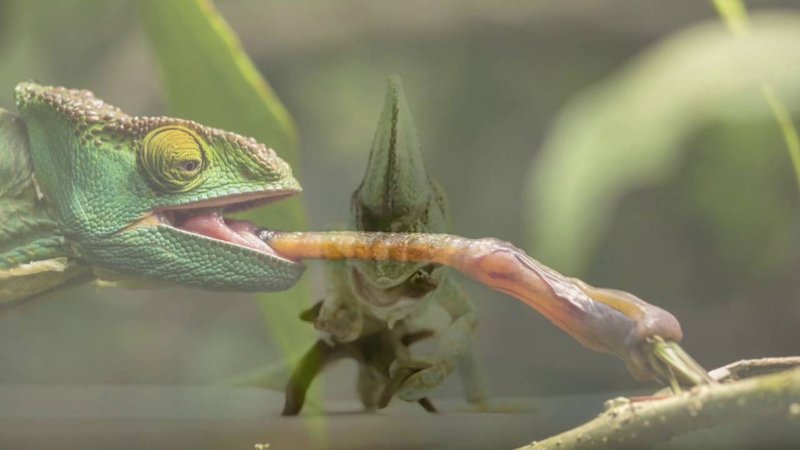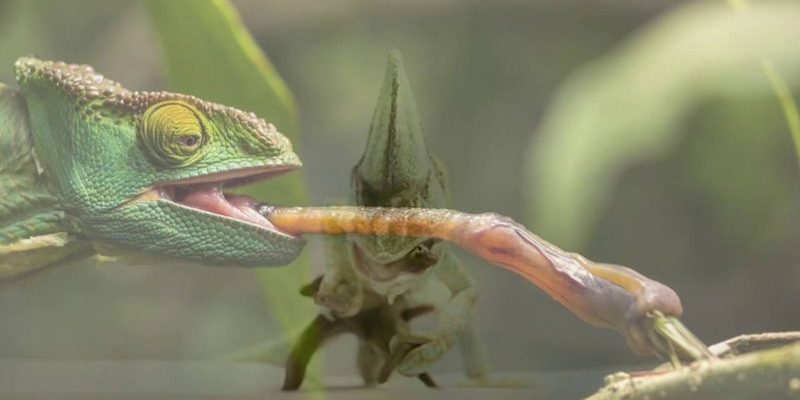
These lizards have a unique style of hunting that’s just as intriguing as their diet. From their sticky tongues to their slow, deliberate movements, chameleons have mastered the art of catching prey. So, grab a coffee, and let’s dive into the world of chameleons—what they eat and how they go about hunting their meals.
What Do Chameleons Typically Eat?
Chameleons are primarily insectivores, which means they feast on insects. They have a varied diet that can include:
- Crickets
- Mealworms
- Roaches
- Grasshoppers
- Beetles
- Sometimes, small reptiles and birds
Chameleons can consume different types of insects based on their size and availability. For instance, larger chameleons might snack on bigger insects or even small vertebrates, while smaller species stick to tiny bugs. It’s like going to a buffet where you pick what you crave that day, adjusting your menu based on what’s fresh and available.
It’s worth noting that some chameleons will also munch on plant matter or fruit occasionally, but that’s more of a rare treat rather than a part of their regular diet. Their primary focus remains on catching those insects that provide the essential proteins they need.
The Chameleon’s Hunting Method
When it comes to hunting, chameleons have a unique approach that’s almost theatrical. They rely on a combination of patience, stealth, and some impressive physical adaptations. Here’s how they do it:
1. Stalking: Chameleons often sit still and blend into their environment, waiting for unsuspecting insects to wander by. Their ability to change color isn’t just for show; it helps them stay hidden. It’s as if they’re playing a game of hide and seek, with their dinner being the ultimate prize.
2. Eyes: Did you know that a chameleon can move each eye independently? This means they can scan for prey while maintaining a lookout for potential threats. Imagine having a superpower like that! Their eyes provide a wide field of vision, making it easier to spot an insect on the move.
The Sticky Tongue: An Ingenious Tool
One of the most remarkable features of chameleons is their long, sticky tongues. These can be as long as their body and enable them to catch prey from a distance. Here’s how it works:
– Rapid Extension: When a chameleon spots its target, it can flick its tongue out in a fraction of a second. This rapid movement allows it to catch insects that may be resting or flying nearby.
– Adhesive Tip: The tip of the tongue is covered in a sticky saliva that allows it to grasp insects effectively. It’s like having a super-advanced fishing rod that reels in lunch!
What’s even cooler is that once the chameleon catches its prey, it quickly retracts its tongue, pulling the insect into its mouth without missing a beat. This hunting method is not only efficient but also minimizes the risk of being spotted by predators.
Hunting in Different Environments
Chameleons can be found in a variety of habitats, from lush rainforests to arid deserts. This means their hunting techniques might vary slightly based on their environment:
– Rainforests: In these lush settings, chameleons can use the dense foliage to their advantage. They often hang out on branches, waiting for insects drawn to the flowers and leaves. The abundance of prey means they can afford to be more selective about their meals.
– Deserts: Here, chameleons might have to work harder. Insects can be scarce, so they may have to travel further or adapt their strategies. Their camouflage helps them remain discreet while hunting.
It’s fascinating how these lizards adapt their hunting skills to fit their surroundings. Think of them as nature’s ultimate survivalists, always finding ways to thrive in various conditions.
Factors Influencing Their Diet
Several factors can influence what chameleons eat and how they hunt:
– Availability of Prey: Just like any predator, chameleons need to adjust their food choices based on what they can find. In areas where certain insects are plentiful, they can focus on those as their primary food source.
– Seasonal Changes: As seasons change, so do the populations of various insects. During the rainy season, for example, chameleons may find more food options due to increased insect activity.
– Size and Age: Larger chameleons can often take down bigger prey, while younger ones will stick to smaller options. It’s all about finding what’s safely manageable!
These factors shape a chameleon’s dietary habits, making them adaptable and resilient in the wild.
Increasing Awareness of Chameleon Diet
Understanding what chameleons eat and how they hunt isn’t just fun trivia; it’s vital for their conservation. Many species are threatened by habitat loss and the pet trade. Here’s why knowing about their diet matters:
– Captive Care: For those who keep chameleons as pets, providing a diet that mirrors what they would eat in the wild is crucial for their health. A diverse diet ensures they receive the right nutrients.
– Natural Habitats: By preserving their ecosystems and the insects they rely on, we contribute to their survival. Supporting conservation efforts can help maintain the delicate balance in their habitats.
So, as you learn about these amazing lizards, consider how we can help them thrive in the wild. Every little action counts!
Chameleons are more than just color-changing wonders; they’re complex creatures with unique diets and hunting methods. From their sticky tongues to their incredible camouflage, these lizards have perfected the art of survival. Understanding what they eat and how they hunt not only deepens our appreciation for them but also highlights the importance of preserving their habitats.
Next time you spot a chameleon, whether in a zoo or a nature documentary, remember the intricate world of food and hunting that lies beneath its colorful exterior. Let’s keep learning and advocating for these remarkable creatures, ensuring they continue to thrive in the wild for generations to come.

